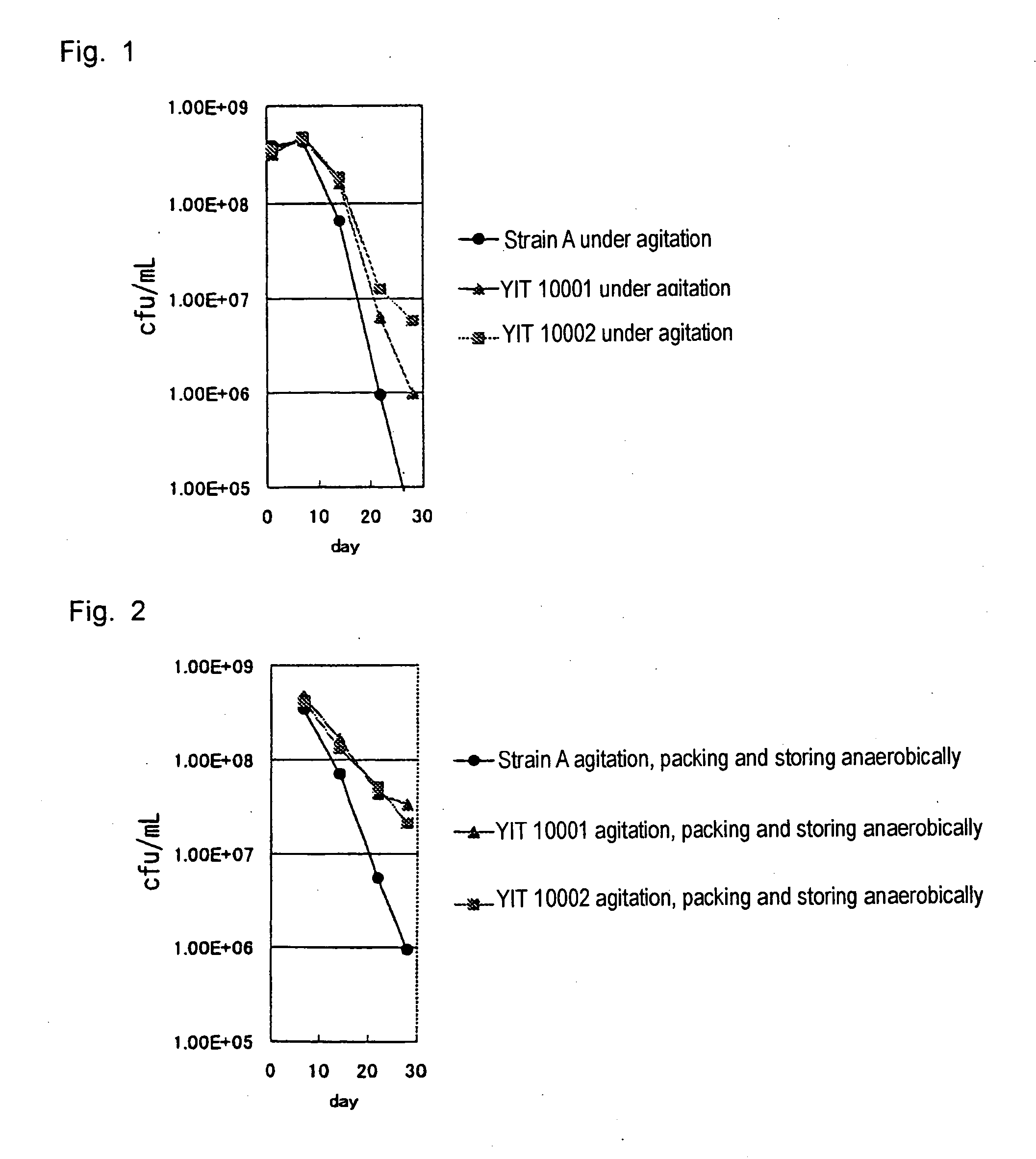Bacterium of the genus bifidobacterium and fermented foods using the same
a technology of bifidobacterium and fermented foods, which is applied in the direction of bacteria based processes, biocide, microorganisms, etc., can solve the problems of difficult to maintain the viability of bacteria in the fermented foods which were aerobically stored in the production site, and the proliferation of bacteria is difficult to control, etc., to achieve the effect of maintaining the uniformity of fermented foods, improving the viability of bacteria in the fermented product, and high viable coun
- Summary
- Abstract
- Description
- Claims
- Application Information
AI Technical Summary
Benefits of technology
Problems solved by technology
Method used
Image
Examples
example 1
[0037] A parent strain, a strain of Bifidobacterium breve (YIT 4065: FERM BP-6223, deposited in International Patent Organism Depositary, National Institute of Advanced Industrial Science and Technology (Chuo No. 6, 1-1, Higashi-1-chome, Tsukuba, Ibaraki, 305-8566 Japan) on Feb. 2, 1996) (cephalothin-streptomycin resistant strain) and Lactococcus lactis were inoculated into a medium containing 20% skim milk, and mix-cultured at 37° C. for 24 hours to prepare a bacterial solution. To this bacterial solution, a bacterial solution obtained by culturing Streptococcus thermophilus using 20% skim milk at 37° C. for 20 hours was added (mixing ratio=1:2). A syrup solution containing reduced glutinous maltose syrup was added to a final concentration of 5% to prepare a fermented milk product. The fermented milk product was poured into a glass bottle and was agitated using stirrer under aerobic environment with cotton plugged during storage period. Under this condition, the bottle was stored a...
example 2
[0040] Viability Test
[0041]Bifidobacterium breve YIT 10001, YIT 10002 and strain A as the bacteria belonging to the genus Bifidobacterium were used to prepare fermented milk products.
[0042] Namely, 2 lit. of 20% milk medium was charged into a 2.5 L jar-fermenter, strains of the bacteria belonging to the genus Bifidobacterium hereinabove and Lactococcus lactis YIT 2027 were inoculated as seed starters in 2% and 0.01%, respectively, and cultured at 37° C. for 24 hours to prepare a bacterial solution by homogenizing at 15 Mpa. Streptococcus thermophilus was cultured in 20% skim milk at 37° C. for 20 hours to prepare a bacterial solution by homogenizing at 15 Mpa. These bacterial solutions were mixed at a ratio of 1:2, and a syrup solution containing reduced glutinous maltose syrup was added to the final concentration of 5% to prepare a fermented milk product (viable counts were: strain A 5.65×108 cfu / ml, YIT 10001 5.34×108 cfu / ml, and YIT 10002 5.45×108 cfu / ml).
[0043] Viable counts ...
example 3
[0045] In a 2.5 lit. jar-fermenter, 2 lit. of 24% milk medium was charged. Seed starters of Bifidobacterium breve YIT 10001 and Lactococcus lactis YIT 2027 were inoculated, in 2% and 0.01%, respectively, and cultured at 37° C. for 24 hours to prepare a bacterial solution by homogenizing at 15 Mpa. Seed starters of Lactobacillus casei and Lactobacillus acidophilus were inoculated each in 0.5% in 20% skim milk, cultured at 37° C. for 24 hours to prepare a bacterial solution by homogenizing at 15 Mpa. These bacterial solutions were mixed at a ratio of 2:3, and a syrup solution containing palatinose was added to a final concentration of 10% to prepare a fermented milk product (Initial viable count of YIT 10001: 5.76×108 cfu / ml).
[0046] In the fermented milk product, YIT 10001 exhibited a rate of viability of 30% or more after the storage at 10° C. for 2 weeks under agitation in the same way as in Example 1. Taste was also good.
PUM
 Login to View More
Login to View More Abstract
Description
Claims
Application Information
 Login to View More
Login to View More - R&D
- Intellectual Property
- Life Sciences
- Materials
- Tech Scout
- Unparalleled Data Quality
- Higher Quality Content
- 60% Fewer Hallucinations
Browse by: Latest US Patents, China's latest patents, Technical Efficacy Thesaurus, Application Domain, Technology Topic, Popular Technical Reports.
© 2025 PatSnap. All rights reserved.Legal|Privacy policy|Modern Slavery Act Transparency Statement|Sitemap|About US| Contact US: help@patsnap.com

